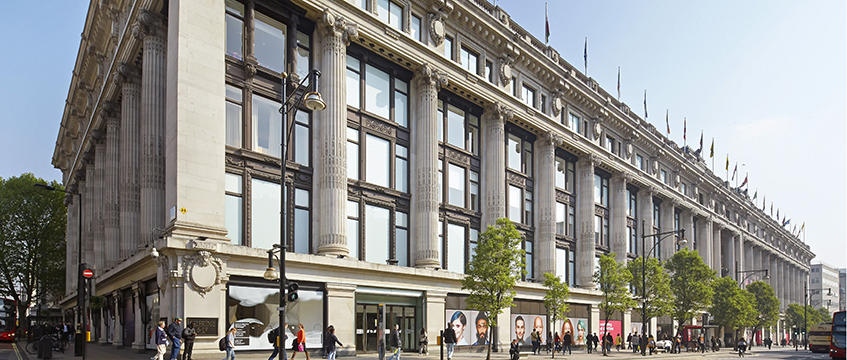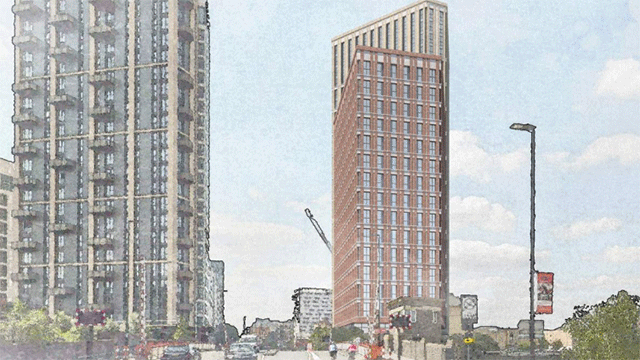Ever since Sir Philip Green bought the Arcadia Group for £850m in 2002, the retail empire has relied heavily on a strong high street presence. For at least a decade, its sprawling store expansion strategy for its current brands – Topshop/Topman, Miss Selfridge, Evans, Wallis, Dorothy Perkins, Burton and Outfit – fuelled the rapid rise of fast fashion both domestically and internationally.
Fast forward to 2018, however, and its struggle to adapt to changing customer demand has become painfully evident in recent years. The rapid rise of pureplay online rivals, including Asos and Boohoo, and value players such as Primark, have eroded its market share significantly.
Presences across hundreds of the UK’s high streets, shopping centres and retail parks have not been enough to combat declining sales or rising overheads, leaving the future of its vast store estate up in the air.
The catastrophic sale and subsequent demise of BHS – which resulted in the closures of its final 159 shops and Arcadia’s £100m concession business at the department store – did little to whittle down the group’s extensive portfolio.
Arcadia’s standalone shop count, which has become somewhat opaque in recent years, has often enjoyed a boost from the inclusion of its retail concessions and franchise outlet numbers; therefore, it is tricky to pinpoint a precise like-for-like decline in the stores it is trading from.
According to its most recent accounts, filed by parent company Taveta Investments in May, the group traded from 2,805 standalones, franchise stores and concessions covering 6.4m sq ft of space in the year to 26 August 2017. It closed 234 of these during the 12-month period, but opened 273.
However, a breakdown of its UK store estate paints a clearer picture. Figures from Radius Data Exchange show that the group’s UK portfolio, excluding concessions and franchise outlets, remains vast, sprawling across 604 stores – 4.8m sq ft – across all of its brands.
Many of these units fall under shared branding, most commonly Topshop and Topman, which cover a combined 1.3m sq ft of dual and standalone offerings.
The portfolio of current stores is distributed throughout the UK, with 30% in the South East and London, spanning 1.4m sq ft of shopping centre, retail park and high street space.
Notably, Dorothy Perkins was the most dominant high street fascia with 199 locations across the UK. Topshop had 173, followed by Burton with 166 fasciae. Topman came fourth, with 162. Arcadia additionally has concession agreements with large retailers including Tesco and Debenhams.
Scaling back
So far, Arcadia has furtively closed 20 retail units during 2018, already surpassing the total number of closures in the whole of 2017, which tallied 17.
Some of these units comprise multiple brands, such as its closures at Westfield London, which consisted of four shops – Evans, Wallis, Burton and Dorothy Perkins – in a row.
The closures so far in 2018 amount to 110,906 sq ft of vacated retail space, accounting for nearly a third of total space relinquished since 2011, although this figure – 341,191 sq ft – excludes store launches.
And there are evidently more closures to expect as the rest of the year unfolds – notably, the data does not include the imminent closures of Dorothy Perkins and Burton in Redcar, Teesside, both of which are expected to shut after 15 years of trading.
In comparison, there has only been one store opening this year: a new Topshop/Topman at Lincoln Waterside Shopping Centre, spanning 11,300 sq ft.
High street downturn
Independent retail analyst Richard Hyman points out that Topshop’s Oxford Circus store is still visibly “buzzing and trading very strongly”; however, the bigger challenge is performance across the rest of Arcadia’s retail offering, particularly where its other clothing brands are concerned.
In its most recent accounts, parent company Taveta Investments posted a 42% decline in operating profit before goodwill, amortisation and exceptional items to £124.1m, in the year to 26 August 2017.
Total sales slid by 5.6% to £1.9bn during the year, while sales at Topshop/Topman, which accounts for nearly half of total sales, fell by 6% to £933.6m.
Topshop/Topman was also hit by £12.6m in expenses, mainly owing to an impairment on fixed assets and provisions for onerous leases on loss-making stores. During the year it raised its provision for new loss-making stores to £4.2m, up from £730,000.
“Arcadia has seen its sales decline progressively over quite some years now. Managing decline like that is very tricky – there are so many moving parts,” says Hyman. “This is the toughest retail market there has ever been. It’s massively oversupplied. Even the good retail brands are having to run much faster to stand still, and most of the Arcadia brands had their heyday many, many years ago.”
The parent company said at the time that “numerous buying options” available to customers and increasing competition from new entrants in the digital sector meant that market conditions remained “challenging and competitive”.
In the meantime it reaffirmed its commitment to close loss-making stores as leases continued to expire and, in some cases, replace them with either concessions, other franchise outlets or stores.
The group reported that £124.9m was invested in capital projects during the 12 months, of which £27.1m related to new stores – 10% down on the previous year’s equivalent investment of 30.1m.
Rerouting investment
On the other hand, a substantial part of the £124.9m capex was directed at its logistics operations. As part of its bid to beef up its online business, the group is preparing to move into a new 1m sq ft freehold distribution centre in Daventry, Northamptonshire, after buying 404,000 sq ft of land for around £40m from Prologis at its DIRFT site in the East Midlands in 2016.
It is not clear precisely how the site, known as Project Trinity, will affect its three DHL-operated Spectrum for Arcadia depots in Solihull, Leeds and Milton Keynes when construction completes in 2019.
However, consolidation between these could be on the cards, particularly where it concerns the nearby Redmoor depot. Both the distribution centre and investment in the retail group’s digital platform are expected to incur projected spend of £81.5m during its 2017-18 financial year.
Either way, it has the potential to go some way towards addressing the retailer’s problems, even if it could not have been done sooner. As Hyman points out: “The core factor is what the [product] offer is. This determines how many stores a retailer should have – not the other way round.
“The main challenge for [Arcadia] is to breathe new life, energy and relevance into what is a group of pretty tired brands and to make them different and current. But this requires significant investment.”
Shrinking globally
Meanwhile, Arcadia’s covert withdrawal from the high street has not been limited to the UK, since it has also terminated a number of franchise agreements in the past year.
Just before its August 2017 year-end, the group bought four Australian shops after its nine-store franchise operations in the continent collapsed into administration last year.
Topshop has broadly stuck to its strategy of rolling out up to 15 Topshop stores across the US – in November it opened its first store in Florida at Aventura Mall, bringing its store count in the region to 11.
Outside the US, however, its franchise footprint has drastically reduced in recent months. It withdrew its physical stores in South Africa, with closures across its remaining seven locations staggered over the summer
Details of these closures emerged weeks after the retailer cut its ties with Chinese licence partner Shangpin, having only recently outlined plans to open more than 100 Topshop and Topman retail stores in China in the next five years – starting with a three-storey, 36,600 sq ft (3,400 sq m) flagship launch in Shanghai, slated to launch in September.
Earlier this year the group also closed its Topshop/Topman store in Prague, which was operated by Kuwaiti company Alshaya.
And in October it closed its four Topshop stores in Spain: one in Barcelona, its only directly-owned location, as well as its stores in Madrid, Marbella and Granada, operated by local partner Glasak.
The closures are a far cry from Green’s vow in 2013 to open more than 150 franchise stores outside the UK across the company’s brands – a goal that is slipping out of reach.
Lease expiries
Arcadia’s store closure strategy used to be much clearer. Back in 2011, Green made no secret of his desire to offload around 250 stores, as lease agreements on 460 of Arcadia’s shops came up for expiry in the run-up to 2014. At the time, the group operated 2,500 stores, including BHS stores, with 3,100 outlets worldwide.
In the years that followed, Green became renowned in the industry for his combative stance – whether on rent renegotiations, store closures or, more historically, launches. One senior City insider, who previously advised Green in related matters, describes his negotiating style as “hyper-aggressive” with a predilection for “banging on the table” in an effort to get his way.
However, this appears to have abated in more recent times. Several industry figures note a lack of engagement on a discernible store strategy outside renegotiations as leases expire, to Arcadia’s detriment. It is also broadly perceived that Green himself is retreating from the front line.
“It has lost its way. Topshop was a great retailer at one point in time, but times have changed,” the City source adds.
This has recently been exacerbated by the departure of long-standing property director Chris Harris, who left the business last October after 11 years to take up a property and development directorship at John Lewis.
A spokesperson for Arcadia said there “hasn’t been any change” since Harris left, and that the group has maintained “the same level of engagement with the major landlords”.
However, one experienced retail agent with knowledge of the matter perceives Harris’s exit as a “significant blow” for the retailer. He observes that since his departure, “there isn’t a dialogue going on at all”.
He also notes that its stores on the whole remain “totally un-invested in”, while the retailer continues to ask for significant rent reductions upon lease expiry.
Like several retailers, it is also pushing for more breaks in existing agreements – something that the industry is broadly on board with. “Bar one or two stores, why would you try to keep them open, especially with the brands that aren’t Topshop?” the agent asks.
Changing attitudes
This apparent listlessness has accompanied widespread sentiment that landlords are becoming sidelined by retailers in their respective missions to cut costs where they can.
“There is no desire now from a retail tenant like Arcadia to have or form a relationship with landlords,” says the agent. “It’s almost like being a tax guy nowadays. Retailers are [pushing] the process of property and asset management right down the hierarchy, which makes things difficult.”
Hyman says that it is now down to the landlords to ensure they are proactively reassessing how they interact with occupiers to strengthen ties. “Most retailers cannot afford the rent they pay. They have been slow to see the writing on the wall, and landlords have been even slower,” he remarks.
“The one thing we can be sure of is that over the coming years, landlords will be earning less rent from retail. This will either be thrust upon them, or they can play a part in negotiations to recalibrate the financial relationship between landlords and tenants.”
At the height of its game, Arcadia ruled over the high street. But now, as landlords are scrambling to deal with its steadily diminishing physical footprint, it has become clear that it is failing to keep up with the rapidly changing retail environment.
Physical retail is far from dead – the most recent ONS figures show that despite its rapid growth, online sales accounted for just over 17% of total retail sales in 2018. But without a solid and meaningful strategy for reinvention or added investment, Arcadia’s chances of recapturing its halcyon days will eventually fade away along with its stores.
Verdict: a slow but natural consolidation
James Child, retail analyst, EG
“What we are seeing is the slow but natural consolidation of the Arcadia portfolio. Many of the stores that have closed are because of lease expiry and form the basis of cost reduction as all retailers continue to battle between the change in physical and online retail.
“New Look showed this year that despite fashion being one of the strongest of the retailer sectors, there is still overstretch with the levels of strong competition.
“Online spend now makes up almost 20% of all retail purchases – combine this with top-heavy business rates and rents and you have a situation which means that cost reduction on physical space is necessary.
“It’s not all bad news, though. Arcadia does continue to open new stores in new schemes, focusing on premium locations as the retail market continues its own destination polarisation.”
To send feedback, e-mail pui-guan.man@egi.co.uk or tweet @PuiGuanM or @estatesgazette











